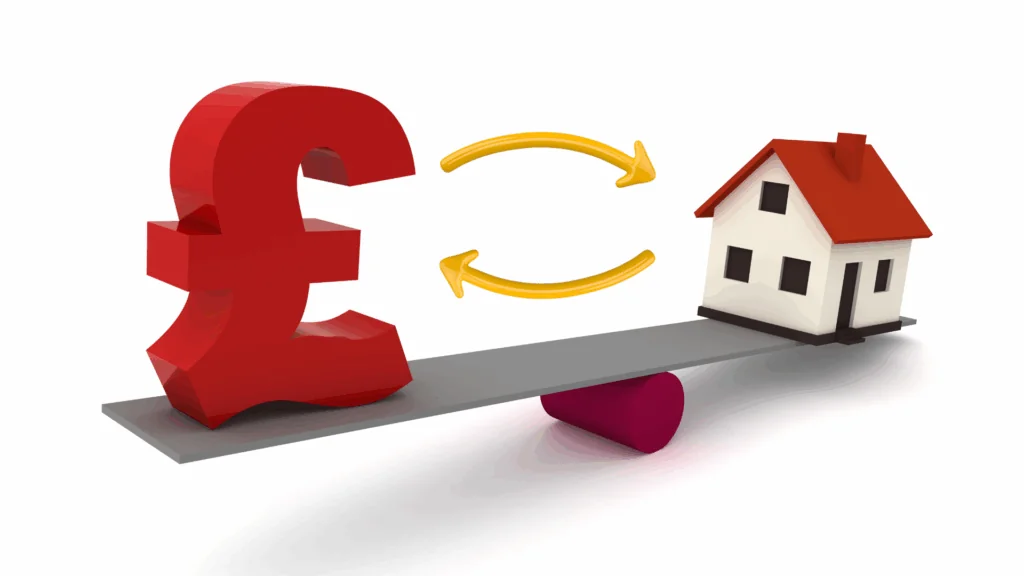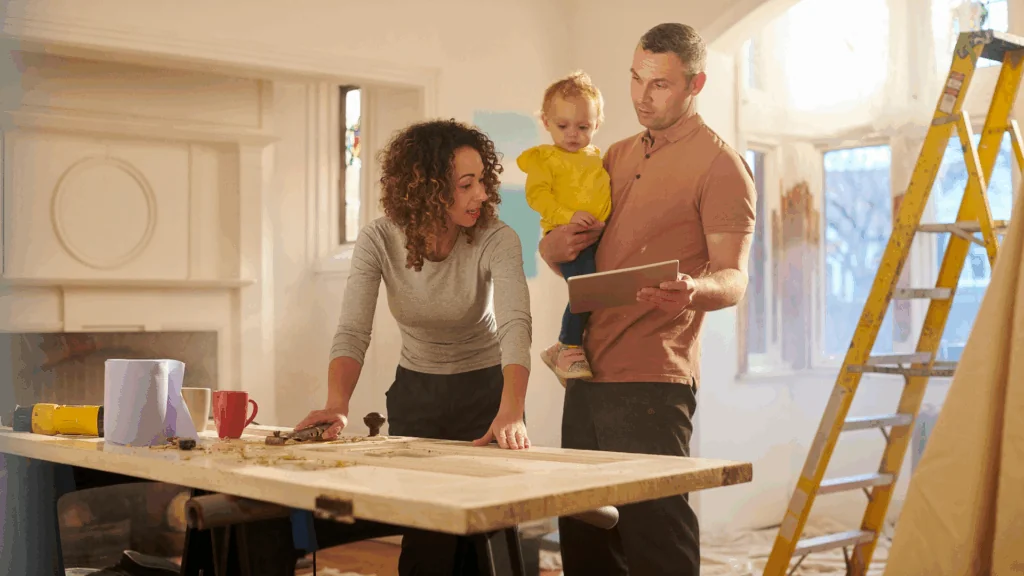- What is a Second Mortgage?
- Can You Get a Second Mortgage for Home Improvements?
- How Do You Get a Second Mortgage for Home Improvements?
- Financial Considerations and Costs
- Why Use a Second Mortgage for Home Improvements?
- What Are the Risks of a Second Mortgage?
- Home Equity Loans vs. Second Mortgages
- Can You Use First Mortgages for Home Improvements?
- Can I Roll Remodel Costs into My Mortgage?
- Legal and Regulatory Considerations
- How Do You Choose the Right Home Improvements?
- Alternative Financing Options for Home Improvements
- The Bottom Line
Can I Use a Second Mortgage for Home Improvements?

Home improvements are great for making your home more comfortable and valuable. But, they can be expensive.
A second mortgage can help you pay for these home upgrades. This means you borrow money based on the value of your house that you own, called equity. It gives you the cash you need for big changes, like building extra rooms or updating your kitchen.
This guide will show you how to use a second mortgage to pay for your home improvements. It’s a way to make your home better for you and might even increase how much it’s worth.
What is a Second Mortgage?
A second mortgage is a loan where you borrow against your home’s value. It’s called a second mortgage because you get it after your first mortgage.
When you go for a second mortgage, you use the equity of your home. Equity is like the actual money value of your home, minus what you still owe on your first mortgage. Let’s say your home is worth £250,000 and you owe £150,000 on your first mortgage. Your equity is £100,000.
A big difference between a second mortgage and other loans, like personal loans, is how they’re secured. For a second mortgage, your home is the security – if you don’t keep up with payments, there’s a risk of losing your home.
Personal loans usually don’t need security, and HELOCs (Home Equity Line of Credit) let you borrow money as needed, not all at once.
Second mortgages are handy for home improvements. By using your home’s equity, you can get the money you need to make your home better and maybe even increase its value, making your home life nicer.
Can You Get a Second Mortgage for Home Improvements?
Yes, you can get a second mortgage for home improvements. It’s a common reason homeowners choose this type of financing.
As discussed earlier, when you take out a second mortgage for home improvements, you’re essentially using your home’s existing equity to invest back into the property.
This can be an effective way to fund significant renovations, extensions, or upgrades that could increase your home’s market value and enhance your living experience.
To obtain a second mortgage for this purpose, you’ll need to go through a process similar to getting your original mortgage.
Here’s what it typically involves:
- Lenders will evaluate your creditworthiness, taking a close look at your credit history and score.
- They’ll assess the current value of your home, along with the amount of equity you have.
- Your ability to repay the loan is a crucial factor. Lenders will examine your income, debts, and overall financial stability.
- Importantly, you’ll often need approval from your first mortgage lender. This is because the second mortgage will be subordinate to the first, and the primary lender must agree to this arrangement.
If your application is successful, you’ll receive a lump sum to use for your home improvement projects.
Pro-Tip
Taking out a second mortgage means more debt, so handle it smartly.
Make sure the loan costs are worth the home improvements you’re planning. And think about how this will affect your money in the long run before you decide.
How Do You Get a Second Mortgage for Home Improvements?
To get a second mortgage for home improvement, it’s important to plan and understand the process involved in it. Here’s a general guide to help you through:
- Assess Your Equity. First, figure out how much equity you have in your home. Equity is the difference between your home’s current market value and what you still owe on your first mortgage.
- Check Your Credit Score. Your credit history and score are important. Lenders use them to gauge your ability to repay the loan. Ensure your credit score is in good shape.
- Get Approval from Your First Mortgage Lender. This is an essential step. Your first mortgage lender needs to give the green light for a second mortgage since it affects their security.
- Shop Around for Lenders. Look for lenders offering second mortgages. Compare their terms and conditions, interest rates, and fees.
- Prepare Your Documentation. Gather all necessary documents, including proof of income, employment details, current mortgage statements, and any other financial obligations.
- Apply for the Mortgage. Complete the application form with accurate details. Be transparent about your financial situation.
- Property Valuation. The lender will likely want a valuation of your property to confirm its worth.
- Read the Fine Print. If your application is successful, carefully review the loan terms before accepting.
Financial Considerations and Costs
Understanding the financial implications of a second mortgage for home improvements is crucial. Here’s what you need to know:
- Interest Rates. The interest rate on a second mortgage might be higher than your first mortgage. It’s important to compare rates from different lenders to get the best deal.
- Fees. Be aware of any additional fees, such as arrangement fees, valuation fees, or legal costs. These can add up, so factor them into your overall cost.
- Repayment Terms. Second mortgages come with different repayment terms. Some might be over five years, others could extend to twenty. Longer terms might reduce your monthly payments but increase the total amount of interest you pay.
- Risks. Remember, your home is collateral. If you can’t keep up with repayments, you risk losing your home.
- Impact on Your Finances. Consider how a second mortgage fits into your overall financial situation. It’s a long-term commitment that requires regular repayments.
Why Use a Second Mortgage for Home Improvements?
Opting for a second mortgage for home improvements can be a smart financial move for several reasons:
- Access to Large Funds. If you have substantial equity in your home, a second mortgage can provide a sizable amount of money. This is ideal for significant home improvements.
- Potential to Increase Property Value. Investing in your home can significantly boost its market value. Whether it’s a new kitchen, extension, or loft conversion, these improvements can make your home more appealing and valuable.
- Lower Interest Rates than Unsecured Loans. Often, the interest rates on a second mortgage are lower than those on unsecured loans like personal loans or credit cards. This can make borrowing more cost-effective in the long run.
- Personal Satisfaction. Beyond the financial aspects, improving your home can lead to greater comfort and enjoyment of your living space.
What Are the Risks of a Second Mortgage?
While there are benefits, a second mortgage also comes with risks that you need to be aware of:
- Risk of Losing Your Home. Since your home is used as collateral, failing to make payments can lead to repossession.
- Additional Debt. A second mortgage increases your overall debt burden. It’s essential to ensure that you can manage the additional monthly repayments alongside your other financial commitments.
- Higher Overall Cost. While the monthly payments of a second mortgage might seem manageable, the total cost over the term of the loan can be high. This includes interest and fees. For instance, borrowing £30,000 over 15 years at an interest rate of 7.5% could end up costing around £50,059 in total.
- Impact on Credit Score. Just like any form of borrowing, a second mortgage can affect your credit score. Missed payments or defaults will have a negative impact.
Home Equity Loans vs. Second Mortgages
Home equity loans and second mortgages might seem similar, but they have some key differences.
A home equity loan is a one-off lump sum based on your home’s equity – the part of your home you truly own. You borrow a chunk of your home’s value and pay it back with interest.
On the other hand, a second mortgage is a separate loan you get in addition to your first mortgage. It’s also based on your home’s equity, but it’s a distinct loan, not part of your original mortgage.
One major difference is in interest rates. Home equity loans usually have fixed rates, so your repayments don’t change. Second mortgages might have variable rates, which means the amount you pay back could go up or down.
Another difference is how you repay them. Second mortgages often offer more flexibility and different lengths of time to pay back the loan compared to home equity loans.
While both can be used for things like home improvements, they’re not the same. Each type of loan has its own rules, interest rates, and financial structure.
Can You Use First Mortgages for Home Improvements?
A first mortgage can be a practical solution for funding home improvements. This method involves initial financing, not refinancing.
When you’re buying a property to make renovations, these costs can be included in your first mortgage application.
For example, consider a property requiring a £150,000 mortgage. If renovations are estimated at £30,000, you might apply for a £180,000 mortgage.
The feasibility of this depends on your lender and financial status. This strategy is particularly beneficial when purchasing properties that need substantial improvements, often referred to as ‘fixer-uppers’.
Can I Roll Remodel Costs into My Mortgage?
Absolutely! When buying a new home, you can wrap remodelling costs into your mortgage, letting you finance both the purchase and the renovations.
Think of it like this: you’re not just borrowing for the home itself, you’re also getting extra cash to make it your dream space. This can cover big changes, like rearranging rooms or adding an extension.
But be warned, it’s not as simple as throwing on a fresh coat of paint. Big remodels can seriously change the value and structure of the place, so lenders take a closer look.
They might ask for detailed plans or suggest special mortgage types for major renovations or even building projects.
The key is to balance your renovation dreams with what lenders are comfortable with. Get all your ducks in a row, and you’ll be well on your way to a home that’s both perfect and perfectly financed.
Legal and Regulatory Considerations
When undertaking home improvements with a second mortgage, it’s crucial to be aware of relevant UK laws and regulations:
- Planning Permission. Some home improvements may require planning permission, especially if you’re extending or significantly altering your property. Check with your local council to see if your project needs this.
- Building Regulations. These are standards for design and construction which apply to most types of building work. Ensure your project complies with these regulations to avoid any legal issues.
- Mortgage Lender’s Permission. If you have a mortgage, you might need your lender’s permission for major alterations, particularly if they could affect the property’s value.
- Insurance Considerations. Inform your home insurance provider about any major improvements, as they can affect your coverage.
- Where to Seek Information. For further information, you can consult the UK government’s Planning Portal or seek advice from legal professionals specialising in property law.
By taking these considerations into account, you can make informed decisions about your home improvements, ensuring they are not only beneficial for your enjoyment and property value but also legally compliant.
How Do You Choose the Right Home Improvements?
Choosing the right home improvements is key to ensuring that you not only enhance your living experience but also potentially increase your property’s value. Here’s how to make the right choices:
- Assess Your Needs and Desires. Start by considering what you most need or want from your home. Is it more space, updated features, or maybe energy efficiency? Your personal needs should guide your decision.
- Consider Market Trends. If you’re looking to increase your home’s value, think about current market trends. For example, updated kitchens and bathrooms often offer a good return on investment.
- Budget Wisely. Set a realistic budget for your project. It’s important to ensure that the cost of improvements doesn’t outweigh the potential increase in property value.
- Think Long-Term. Choose improvements that will be beneficial for years to come, not just temporary fixes or overly personalised projects that might not appeal to future buyers.
- Seek Professional Advice. Consult with property experts or architects, especially for larger projects. They can provide valuable insights into what improvements are likely to add the most value.
Alternative Financing Options for Home Improvements
When you’re looking at financing options for home improvements, a second mortgage is a well-known route, but it’s not the only one. Here are several alternatives to consider:
Refinancing Your Mortgage
Think about changing your current mortgage for a new one that’s a bit bigger. This way, you can use the extra cash for your home improvements.
For example, if you owe £100,000 now, you could switch to a £130,000 mortgage and use the £30,000 difference to spruce up your home.
Just remember, this could mean extra charges if you pay back early, and it affects how much you owe against your home.
These loans are made for fixing up your house. You can get them in two types: secured and unsecured.
Secured loans use your house as a safety net for the lender, which usually means better interest rates for you, similar to a second mortgage.
Unsecured loans are faster to get but might cost you more in interest since they don’t use your home as security. Your choice here depends on how much you’re willing to risk your home and your overall money situation.
Personal Loans and Credit Cards
If you’re only making small changes, a personal loan or credit card could do the trick.
They’re usually more expensive in terms of interest than loans secured against your home, but they don’t put your house at risk.
Just be careful with larger projects, as the higher interest and lower limits might not be the best deal.
Home Equity Line of Credit (HELOC)
A HELOC lets you borrow money against your home’s value, a bit like a credit card limit. You use what you need and pay interest only on that amount during the initial period.
After that, you start paying back the borrowed amount plus interest. This is handy for big projects that happen in stages over time.
Remortgaging for Home Improvements
Another idea is to remortgage your home. This means switching your mortgage to a different deal, maybe even with a new lender.
It can give you better terms or interest rates and help consolidate your debts. But remember, this might stretch out the time you’re paying back the mortgage and increase the total amount you pay back.
Government Grants and Schemes
Sometimes, there are government grants or schemes, especially for making your home more energy-efficient.
These can help pay for specific kinds of home improvements. It’s worth checking out if you’re planning to make your home greener.
Each of these choices has its ups and downs, so think about what works best for your home improvement plans and your wallet. It’s all about finding the right fit for your project and financial situation.
The Bottom Line
Taking out a second mortgage for home improvements can be a smart move for enhancing your home and potentially increasing its value.
This method allows you to use the equity in your home to fund significant renovations, from kitchen remodels to room extensions.
However, it’s not a decision to take lightly.
Before you decide, think hard about the extra debt and the costs like higher interest rates. Remember, your home is the security for this loan.
Ask yourself if you can handle the extra monthly payments and if the improvements will add value to your home.
If you’re not sure, getting advice from a financial expert is a good idea. They can look at your situation and give you advice that’s just right for you. They can also help you with all the paperwork.
Need help finding the right mortgage advisor? Just get in touch, and we’ll match you with the perfect one for your needs.
Get Matched With Your Dream Mortgage Advisor...

Frequently asked questions
How much can I borrow for a second mortgage for home improvements?
The amount you can borrow with a second mortgage for home improvements largely depends on the equity in your home.
Equity is the portion of your property that you own outright, which is the current value of your home minus any outstanding mortgage balance.
Lenders typically allow you to borrow a certain percentage of this equity. Your borrowing capability is also influenced by your income, credit history, and current financial situation.
It’s important to note that each lender has different criteria and limits, so the maximum amount can vary. To get a precise figure, it’s best to speak directly with lenders or consult a mortgage advisor.
This article has been fact checked
This article was created, checked, and verified by the expert team at Money Saving Guru. Trust us, you’re in good hands.




